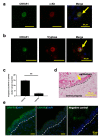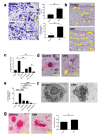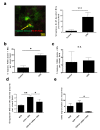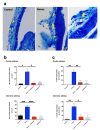Stress and Nasal Allergy: Corticotropin-Releasing Hormone Stimulates Mast Cell Degranulation and Proliferation in Human Nasal Mucosa
- PMID: 33803422
- PMCID: PMC7967145
- DOI: 10.3390/ijms22052773
Stress and Nasal Allergy: Corticotropin-Releasing Hormone Stimulates Mast Cell Degranulation and Proliferation in Human Nasal Mucosa
Abstract
Psychological stress exacerbates mast cell (MC)-dependent inflammation, including nasal allergy, but the underlying mechanisms are not thoroughly understood. Because the key stress-mediating neurohormone, corticotropin-releasing hormone (CRH), induces human skin MC degranulation, we hypothesized that CRH may be a key player in stress-aggravated nasal allergy. In the current study, we probed this hypothesis in human nasal mucosa MCs (hM-MCs) in situ using nasal polyp organ culture and tested whether CRH is required for murine M-MC activation by perceived stress in vivo. CRH stimulation significantly increased the number of hM-MCs, stimulated both their degranulation and proliferation ex vivo, and increased stem cell factor (SCF) expression in human nasal mucosa epithelium. CRH also sensitized hM-MCs to further CRH stimulation and promoted a pro-inflammatory hM-MC phenotype. The CRH-induced increase in hM-MCs was mitigated by co-administration of CRH receptor type 1 (CRH-R1)-specific antagonist antalarmin, CRH-R1 small interfering RNA (siRNA), or SCF-neutralizing antibody. In vivo, restraint stress significantly increased the number and degranulation of murine M-MCs compared with sham-stressed mice. This effect was mitigated by intranasal antalarmin. Our data suggest that CRH is a major activator of hM-MC in nasal mucosa, in part via promoting SCF production, and that CRH-R1 antagonists such as antalarmin are promising candidate therapeutics for nasal mucosa neuroinflammation induced by perceived stress.
Keywords: CRH; mast cell; nasal mucosa; psychological stress; stem cell factor (SCF).
Conflict of interest statement
The authors declare no conflict of interest.
Figures






Similar articles
-
Corticotropin-releasing hormone stimulates the in situ generation of mast cells from precursors in the human hair follicle mesenchyme.J Invest Dermatol. 2010 Apr;130(4):995-1004. doi: 10.1038/jid.2009.387. Epub 2009 Dec 31. J Invest Dermatol. 2010. PMID: 20043013
-
Corticotropin-releasing hormone induces skin mast cell degranulation and increased vascular permeability, a possible explanation for its proinflammatory effects.Endocrinology. 1998 Jan;139(1):403-13. doi: 10.1210/endo.139.1.5660. Endocrinology. 1998. PMID: 9421440
-
Sorafenib stimulates human skin type mast cell degranulation and maturation.J Dermatol Sci. 2017 Dec;88(3):308-319. doi: 10.1016/j.jdermsci.2017.08.005. Epub 2017 Aug 12. J Dermatol Sci. 2017. PMID: 28843624
-
Corticotropin-releasing hormone and inflammation.Ann N Y Acad Sci. 1998 May 1;840:21-32. doi: 10.1111/j.1749-6632.1998.tb09545.x. Ann N Y Acad Sci. 1998. PMID: 9629233 Review.
-
Stress triggers coronary mast cells leading to cardiac events.Ann Allergy Asthma Immunol. 2014 Apr;112(4):309-16. doi: 10.1016/j.anai.2013.09.017. Epub 2013 Oct 10. Ann Allergy Asthma Immunol. 2014. PMID: 24428962 Free PMC article. Review.
Cited by
-
Allergic Rhinitis-Induced Anxiety and Depression: An Autobiographical Case Report.Cureus. 2023 Mar 23;15(3):e36560. doi: 10.7759/cureus.36560. eCollection 2023 Mar. Cureus. 2023. PMID: 37102007 Free PMC article.
-
Neurodivergence, intersectionality, and eating disorders: a lived experience-led narrative review.J Eat Disord. 2024 Nov 20;12(1):187. doi: 10.1186/s40337-024-01126-5. J Eat Disord. 2024. PMID: 39568093 Free PMC article. Review.
-
The role of mast cells and related molecules in itch of hidradenitis suppurativa.Exp Dermatol. 2024 Mar;33(3):e15061. doi: 10.1111/exd.15061. Exp Dermatol. 2024. PMID: 38532563 Free PMC article. No abstract available.
-
Psychological Stress-Induced Pathogenesis of Alopecia Areata: Autoimmune and Apoptotic Pathways.Int J Mol Sci. 2023 Jul 20;24(14):11711. doi: 10.3390/ijms241411711. Int J Mol Sci. 2023. PMID: 37511468 Free PMC article. Review.
-
Psychological Stress Exacerbates Inflammation of the Ileum via the Corticotropin-Releasing Hormone-Mast Cell Axis in a Mouse Model of Eosinophilic Enteritis.Int J Mol Sci. 2022 Aug 1;23(15):8538. doi: 10.3390/ijms23158538. Int J Mol Sci. 2022. PMID: 35955675 Free PMC article.
References
-
- Philpott C., Erskine S., Hopkins C., Coombes E., Kara N., Sunkareneni V., Anari S., Salam M., Farboud A., Clark A. A case-control study of medical, psychological and socio-economic factors influencing the severity of chronic rhinosinusitis. Rhinology. 2016;54:134–140. doi: 10.4193/Rhin15.272. - DOI - PubMed
MeSH terms
Substances
LinkOut - more resources
Full Text Sources
Other Literature Sources

